| home | stands | games | about | mpjournal | back | links |
Mathematicians have puzzled for centuries over the properties of solid figures. The solid figures most easily categorized are called polyhedra. Only five regular polyhedra exist. Called the Platonic solids, they are the tetrahedron (four triangular faces), the cube (six square faces), the octahedron (eight triangular faces), the dodecahedron (12 five-sided faces), and the icosahedron (20 triangular faces).
The Swiss mathematician Leonhard Euler proposed and proved a very useful
result about networks, which is now called Euler's formula. This formula can
very easily be applied to polyhedra.
Euler's formula is true for a network if, for all points in the network, we can
get to any other point in the network along connecting paths. (This means that
we do not need to think here about "odd" examples of networks, such as
a group of points with no connecting paths.)
Any network of this type consists of a number of vertices (points or nodes)
joined together by a number of edges (paths or arcs). A region enclosed by edges
is called a face (see Diagram 1).
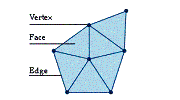
Diagram 1: A Network
Euler showed that, for any network of this type,
number of
vertices - number of edges + number of faces = 1
which can also be written as
V - E + F = 1
We can see this is true for the example in Diagram 1, which has 7 vertices, 12
edges, and 6 faces. Therefore,
V - E + F = 7
- 12 + 6 = 1
For any polyhedron,
V - E + F = 2
This is essentially the same result as the one stated above. We can see this by
taking any polyhedron, removing one of its faces and stretching it out to lie
flat. The edges of the polyhedron will then form the edges of a network with the
same number of edges and vertices as the polyhedron, but with one less face. For
this network
V - E + F = 1
Adding back the face we removed will increase F by 1, and hence will give us
V - E + F = 2
for the polyhedron.
For example, suppose we look at an octahedron. Removing one face and flattening
it out gives us the network in Diagram 2.
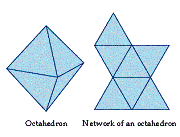
Diagram 2: Euler's Formula for Polyhedra
An octahedron has 6 vertices, 12 edges, and 8 faces. Therefore
V - E + F = 6
- 12 + 8 = 2
The resulting network has 9 vertices, 15 edges, and 7 faces. Therefore
V - E + F = 9
- 15 + 7 = 1
To prove Euler's formula, suppose we start with some network and wish to
prove that V - E + F = 1. If we remove an outside edge from the network
(assuming that it has one), the number of edges in the network will decrease by
one, but so will the number of faces, while the number of vertices remains the
same. Therefore, the value of V - E + F will also remain the same.
For instance, we can see that this is true for our example above (see Diagram
3).
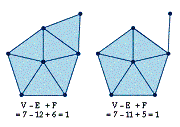
Diagram 3: Removing an Outside Edge from a Network
After removing an outside edge, V = 7, E = 11, and F = 5; therefore
V - E + F = 7
- 11 + 5 = 1
Alternatively, if the network has a vertex connected to the network by only one
edge and we remove both this vertex and the connecting edge, then V and E both
decrease by one, while F remains unchanged. Again, this means that the value of
V - E + F will remain unchanged.
Again, we can see that this is true for an example (see Diagram 4).
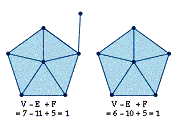
Diagram 4: Removing a Lone Vertex and Connecting Edge from a Network
After removing the lone vertex and connecting edge, V = 6, E = 10, and F = 5;
therefore
V - E + F = 6
- 10 + 5 = 1
Now, if we keep carrying out these two operations, removing an outside edge and
removing a lone vertex and connecting edge, on our network whenever possible, we
will eventually be left with only a single vertex. For this vertex, V = 1, E =
0, and F = 0 and therefore
V - E + F = 1
- 0 + 0 = 1
Since neither of the operations we have carried out on our original network
changes the value of V - E + F, then it must also be true for our original
network that V - E + F = 1 and therefore Euler's formula is correct.
The mathematical notion of a surface is very general, but is based on the
simple intuition of a surface in the physical world. Informally, we speak of the
surfaces of solid objects: for example, "the surface of a table is
flat", or "the surface of a ball is round", or "the ball is
touching the surface of the table". From these sentences we can see that
our informal notion of a surface is that it represents some sort of boundary
between an object and its surroundings and that it can have geometric properties
independent of its surroundings. For instance, a triangle on the surface of a
ball has angles adding up to more than 180 degrees. Also, the surface of a
three-dimensional object, such as a table or ball, is itself two-dimensional.
The formal notion of a surface in mathematics is based on such three-dimensional
intuitions. In particular, a surface in Euclidean three-dimensional space has
two dimensions, though its geometry need not be Euclidean. One reason for
studying such surfaces is that they can have their own geometry, independent of
the surrounding space, while also being quite simple objects. Therefore, they
can be used to study unusual geometries embedded in a more straightforward
geometry. The notion of a surface is not restricted to two-dimensional surfaces
in three-dimensional spaces. A cube is a three-dimensional surface in
four-dimensional space, in fact in any space of dimension greater than three.
However, only surfaces in three-dimensional space are considered here. Some of
the most commonly encountered surfaces are planes, and spherical and cylindrical
surfaces.
A plane is a flat surface such as a tabletop or wall. Any line joining two
points in a plane will lie completely on its surface.
The position of any point in three-dimensional space can be specified by giving
its Cartesian co-ordinates, (x, y, z). For example, the position of the point in
Diagram 1 is given by the co-ordinates (4, 5, 3).

Diagram 1
A plane can be specified by an equation in terms of x, y, and z. Any point that has x, y, and z co-ordinates that satisfy the equation will lie in the plane. For example, the equation z = 0 specifies a horizontal tabletop-like surface, and the equation x = z specifies the plane in Diagram 2. All the points in this plane will have x and z co-ordinates equal to each other.
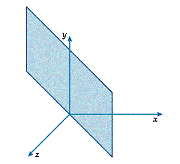
Diagram 2
This plane satisfies the equation x = z.
Most planes have more complicated equations than this. The general equation of a plane is usually given in terms of a normal vector to the plane. A normal line or vector is one that is perpendicular (at right angles) to the plane (see Diagram 3).
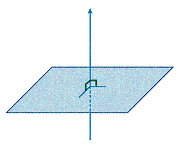
Diagram 3: Normal Vector to a Plane
The general equation of a plane is ax + by + cz = d where
![]()
is a normal vector to the plane. The equation of the plane in Diagram 2 can
be given in this form as
1x + by +
(-1)z = 0
where the vector
![]()
is normal to the plane, and b can be any number.
An example of a spherical surface is the surface of a ball. Every point on a
spherical surface is equidistant (equally distant) from the centre of the
sphere. The equation of the surface of a sphere centred at the Cartesian
co-ordinates (0, 0, 0) is
x2
+ y2 + z2 = r2
where r is the radius of the sphere.
It is easier to see how this equation is derived if the equation of a circle
centred at (0, 0) is considered first (see Diagram 4).

Diagram 4
The radius, r, is, by definition, the distance between any point (x, y) on the circle and the centre of the circle. However, we can also find this distance in terms of x and y by using Pythagoras' theorem. From Diagram 4 it can be seen that the distance is the same as
![]()
In other words,
![]()
or
r2
= x2 + y2
This is the equation of the circle centred at (0, 0).
This concept can now be extended to three dimensions. Imagine that the point (x,
y, z) is on a sphere centred at (0, 0, 0).

Diagram 5
From Diagram 5, it can be seen that
![]()
by Pythagoras' theorem. But f is part of another right-angled triangle and therefore
![]()
So
![]()
or
r2 =
x2 + y2 + z2
The general equation of the surface of a sphere centred at (a, b, c) is
r2 =
(x - a)2 + (y - b)2 + (z - c)2
The surface area of a sphere of radius r is given by 4pr2.
An example of a cylindrical surface is shown in Diagram 6.
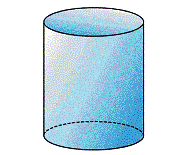
Diagram 6: A Cylinder
The equation of the surface of a cylinder is a bit more difficult to work out
because there are essentially two types of point on a cylindrical surface, those
on the ends of the cylinder and those on the curved surface.
Suppose that the base of the cylinder is the circle in the xy-plane centred
around (0, 0, 0) and the height of the cylinder is h, as in Diagram 7.
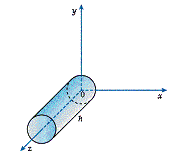
Diagram 7
The equation of the circle around the edge of the base is x2 + y2
= r2. Any point on the base will be on or within this circle and so
the distance between the point and the centre will be less than or equal to r.
Hence all the points on the base will satisfy the inequality
x2
+ y2 £ r2
All the points on the base have a z co-ordinate of 0, so the equation of the
points on the base is given as
x2
+ y2 £ r2, z = 0
The points on the other end of the cylinder have the equation
x2
+ y2 £ r2, z = h
The points on the curved surface of the cylinder can be thought of as being on
the edge of a circle because any cross-section through the cylinder will be a
circle. Therefore all the points on the curved surface of a cylinder will
satisfy x2 + y2 = r2 and their z co-ordinates
will be between 0 and h. Hence,
x2
+ y2 = r2, 0 < z < h
Therefore the equation of the surface of a cylinder with its base in the xy-plane
centred at (0, 0, 0) is given by
x2
+ y2 £ r2 if z = 0 or z
= h
x2
+ y2 = r2 if 0 < z < h
The general equation of the surface of a cylinder with its base in the xy-plane
centred at (a, b) and at z = c is given by
(x - a)2 + (y - b)2 £ r2
if z = c or z = c + h
(x - a)2 + (y - b)2 = r2 if c < z < c + h
The area of the curved surface of a cylinder of radius r and height h is given by the circumference of the circular base multiplied by the height of the cylinder. In other words, the surface area of the curved surface is given by 2prh. The surface area of each end of the cylinder is the area of a circle, pr2. Therefore, the surface area of the whole cylinder is given by 2pr2 + 2prh.
Pyramids are solid figures with triangular sides that meet at the top.
Egyptian pyramids have a square base and are called square-based pyramids. The
cross-section of a pyramid with a square base is square. It is made by cutting a
slice through the pyramid that is parallel to the base.
Tetrahedra resemble pyramids but have four triangular faces of equal size,
including the base, and a triangular cross-section. (Cutting a slice through
this pyramid parallel to its base gives a square cross-section.)